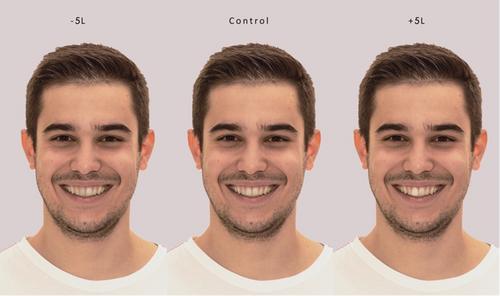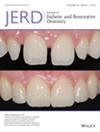Perceptibility and acceptability of lightness difference of a single maxillary central incisor
Abstract
Objectives
The aim of this study was to assess the lightness difference perceptibility and acceptability thresholds, for a single maxillary central incisor, and to investigate possible differences in these thresholds regarding the direction (+ΔL* vs. −ΔL*), the observer group (dentists vs. laypersons), and the gender and age of the observers.
Materials and Methods
A series of images with varying lightness (L*), were created by altering the right maxillary central incisor of a male Caucasian, on a frontal view full-portrait image. Digital modification of one central incisor by 1 ΔL* unit resulted in 15 different images: one control, seven with increased and seven with decreased lightness. The images were presented in random order, on a digitally calibrated monitor, to 158 observers, grouped into 79 dentists, and 79 laypersons, who were asked to evaluate every image and answer whether they perceive a difference and if yes, whether they accept this difference. A multifactorial analysis of covariance was performed to analyze the perception and acceptance of any difference in the central incisors and to estimate the thresholds. The statistical significance level was α = 0.05.
Results
Overall, the magnitude of ΔL*, direction of ΔL*, observer group and age were each significant (p < 0.001), as was gender (p = 0.03). The effect of the magnitude of ΔL* interacted with its direction and the observer group (p = 0.045), and the effect of age interacted with the direction of ΔL*, and the gender and the group of the observers. Estimated 50%:50% perceptibility thresholds ranged from 0.1 to 2.7, and 50%:50% acceptability thresholds ranged from 2.3 to 4.5. Overall, dentists perceived lightness differences at lower magnitudes than laypersons; difference in lightness was perceived and accepted at lower magnitudes when the tooth become lighter instead of darker; and female observers perceived and accepted lightness differences at lower magnitudes compared to males. As age increased overall, differences of lightness were perceived and accepted at higher magnitudes.
Conclusions
Perceptibility and acceptability of lightness differences of a single maxillary central incisor are affected by the magnitude and the direction of lightness change, as well as the gender, the age, and the type of the observers.
Clinical Significance
Even small changes in lightness are perceivable; however, thresholds of perception and acceptance are dependent on the magnitude and the direction of change and are also dependent on the observer, with women, dentists and younger people perceiving and accepting changes at lower magnitudes of ΔL*.


 求助内容:
求助内容: 应助结果提醒方式:
应助结果提醒方式:


